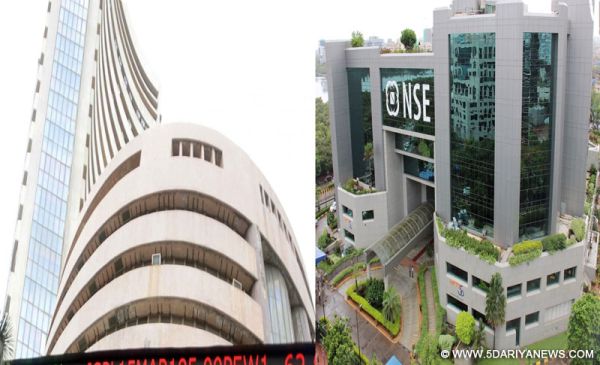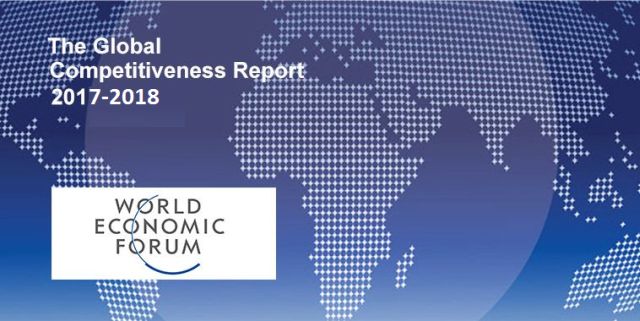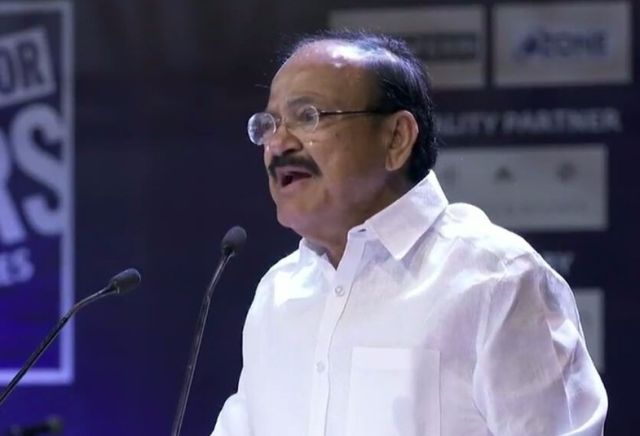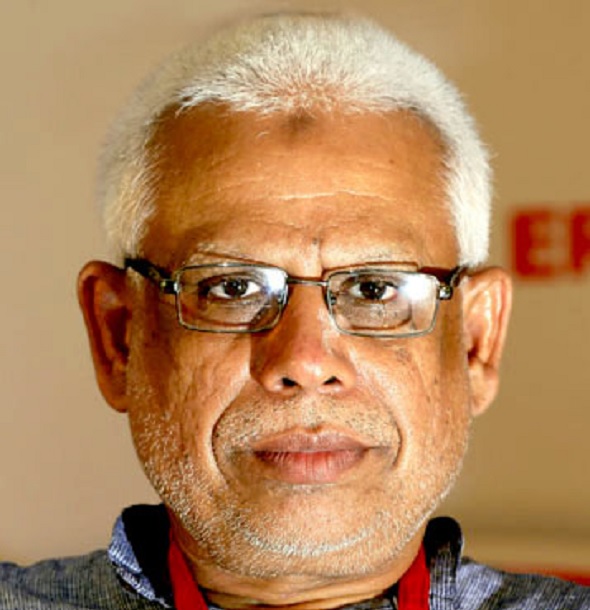
by admin | May 25, 2021 | Economy, Markets, News
 Mumbai : Key Indian equity indices surged during the mid-afternoon trade session on Tuesday as positive global cues, coupled with healthy buying in automobile, consumer durables, and oil and gas stocks, lifted investors’ sentiments.
Mumbai : Key Indian equity indices surged during the mid-afternoon trade session on Tuesday as positive global cues, coupled with healthy buying in automobile, consumer durables, and oil and gas stocks, lifted investors’ sentiments.
According to market observers, expectations of an economic stimulus package aided in the equity markets’ rise.
Around 12.45 p.m., the wider 51-scrip Nifty50 of the National Stock Exchange (NSE) rose by 80.90 points, or 0.83 per cent, to trade at 9,869.50 points.
The 30-scrip Sensitive Index (Sensex) of the BSE, which opened at 31,537.81 points, traded at 31,552.34 points — up 268.62 points, or 0.86 per cent.
The Sensex has so far touched a high of 31,615.28 points and a low of 31,440.48 points during the intra-day trade.
The BSE market breadth was bullish — with 1,497 advances and 962 declines.
“Benchmark indices traded higher with the Nifty50 trading near 9,850 ahead of the Reserve Bank of India’s policy review that kicks off later in the day. The Indian rupee weakened against the US dollar,” Dhruv Desai, Director and Chief Operating Officer of Tradebulls, told IANS.
“Top gainers on the NSE were Tata Motors, Gail and Bajaj Auto, while on the losing side were Power Grid, Maruti Suzuki and State Bank of India,” he added.
On Friday, the benchmark indices closed on a flat-to-positive note as investors booked profits.
The Nifty50 was up 19.65 points or 0.20 per cent to close at 9,788.60 points, while the Sensex closed at 31,283.72 points — up a mere 1.24 points.
—IANS

by admin | May 25, 2021 | Opinions
 By Amit Kapoor,
By Amit Kapoor,
In a respite to the Modi government, which has been facing the heat over dismal economic numbers, the World Economic Forum (WEF) study on global competitiveness for 2017 commended the improving quality of institutions in India, especially in terms of improved efficiency of public spending in the last few years. This was despite the fact that India slipped a place to rank 40 out of a total 137 countries in the Global Competitiveness Index 2017-18.
However, the WEF has clarified that it has changed its methodology this year and the rankings are not comparable with those of last year. Moreover, it also pointed out that this is India’s highest score ever with the new methodology (4.6 compared to 4.5 in the previous year). The country’s score has improved across most indicators of competitiveness, especially infrastructure (66th, an improvement of two points over last year), higher education and training (75th, up six) and technological readiness (107, up two), which is a reflection of recent public investment in these areas.
India has also ranked the highest among all South Asian countries with the next highest being Bhutan and Sri Lanka ranked at 85. Among the BRICS nations, China (27) and Russia (38) rank above India while South Africa and Brazil are placed at 61 and 80. In a major hopeful boost to the dwindling India growth story, the report stated that among the emerging markets that were seen to have great potential in the early 2000s, Brazil and Turkey have lost much of what they had gained before 2013, while China, India and Indonesia continue to grow strong.
The report also gives some useful insights about the growth trends of the Indian economy. First, among the emerging economies, it finds that India and China are gradually developing into major centres of innovation. In a recent study of geographical clusters generating the most patents, three Indian cities appeared in the top 100 with Bengaluru at 43 (with patent activity focused on computer technology), Mumbai at 95 and Pune at 96 (with both registering among the most patents in organic chemistry). Due to such an improvement in the innovative environment within India, the WEF rankings place India at 29 on the innovation pillar for competitiveness.
Since innovation is a major determinant of the long-term growth trends of an economy, these figures bode well for India’s future prospects. However, the improvement comes with a caveat. It has been seen that emerging economies that are doing well in innovation are leaving large sections of the population behind since they are not technologically equipped.
The level of technological readiness of individuals and firms in countries like India and China are relatively low. This indicates that the innovative space in these countries is not quite inclusive in nature. Along with innovation, it is necessary to ensure that more people and firms have the required means to access and make use of the new technology. India fares poorly on that front. As mentioned, India ranks a lowly 107 in technological readiness. As long as there remains such a disconnect between technological strength and technological readiness, the gains from it cannot be shared across the wider economy and will only lead to an unequal society. So, India urgently needs to act upon technological readiness to make its economy competitive on a larger scale.
The second insight from the Global Competitiveness Index is the performance of the health and primary education pillar, in which India ranks at 91 — second-worst only to technological readiness. It cannot be overstated how poor health and education outcomes can affect the competitiveness of a country and its citizens. India has always had a history of poor public investment in health and primary education and it pays a hefty cost for this in terms of its competitiveness. Such a continued trend in the long run will result in an unequal and mostly unproductive society where only the well-off, who manage to provide nutrition and education for their children, will thrive.
Thirdly, the WEF Executive Opinion Survey reveals that the private sector still considers corruption to be the most problematic factor for doing business in India. This finding puts a question mark over the effectiveness of the government’s attack on corruption over the last few years. Lack of access to financing and tax regulations also remain the prime problems for setting up a business in India. The former might gradually subside when the problems of non-performing assets (NPAs) with banks is remedied, while the latter might change once the economy adjusts to the newly-implemented Goods and Services Tax (GST). However, corruption will continue to remain an impediment to the country’s competitiveness and its long-term growth.
Therefore, India might be improving on the competitiveness index owing to high public investment in some crucial sectors, but large ailments within the economy still remain. Problems of corruption and a gross negligence of health and education sectors have always defined India’s competitiveness. A recent growth in innovative tendencies seemed to be a saving grace but as it turns out, there seem to be distributive issues. How India handles these concerns will determine its future.
(Amit Kapoor is Chair, Institute for Competitiveness, India. The views expressed are personal. He can be contacted at amit.kapoor@competitiveness.in and tweets @kautiliya. Chirag Yadav, researcher, Institute for Competitiveness, India, contributed to the article.)
—IANS

by admin | May 25, 2021 | Economy, News, Politics

Venkaiah Naidu
New Delhi : The lack of sanitary conditions in India has a serious economic consequence too as it causes a loss of 6 per cent of the GDP every year, said Vice President M. Venkaiah Naidu on Monday.
In his address at the ‘Safaigiri Awards’ function organised by the India Today Group on the occasion of Gandhi Jayanti, Naidu said that the situation is very serious as facts stand as every family loses approximately Rs 50,000 every year due to unsanitary conditions.
“World Bank report also says that lack of sanitation cost us 6 per cent of our GDP… This is people’s cause. You are not doing any favour to anybody by participating in this because facts, the situation is very serious.
“This has to be understood by us all that we cannot achieve sustained progress if we adopt a ‘business as usual’ approach. We should correctively set for an innovative solution that will make a tangible difference,” Naidu added.
The Vice President also blamed the “everything goes” attitude of the people which is dragging the country behind and said that this will not work anymore.
“This is mission without any commission, so there should not be any remission in this mission. Because this has to become a people’s movement. Unfortunately … this has become the habit of the people ‘sab kaam sarkar karega, hum bekaar baithe to chalega. Aisa nahi chalega” (Government will do everything, I will do nothing. This won’t work),” he said.
“We need to, one work towards creating an atmosphere, change the mindset, secondly, create infrastructure and thirdly we have to think in future going for punitive action also.
“Otherwise in a country of our size with a 130 crore population where people think that we have freedom to do anything.. but at the same time you are affecting others’ health also and you are bringing bad name to the society,” he said.
Naidu also lauded the women for their newfound demand for toilets and refusing to marry if there are none at their in-laws’ houses.
“That will solve some of the problem definitely because everybody needs to get married… It’s not mandatory but it’s required,” he added.
He congratulated those who won the awards saying that they will serve as role models for others.
—IANS

by admin | May 25, 2021 | Economy, Markets, News
 By Rohit Vaid,
By Rohit Vaid,
Mumbai : The Reserve Bank of India’s monetary policy review, coupled with macro-economic data points and expectations of an economic stimulus package, are expected to set the course for Indian equity indices during the truncated week’s trade sessions.
According to observers, market movements will also be affected by geo-political developments, direction of foreign fund flows and crude oil prices.
“This week, markets will look forward to the decision by the MPC (monetary policy committee) and if the MPC, via its statements, offers any hints on policy rate cuts or growth and inflation targets,” said Devendra Nevgi, Chief Executive, Zyfin Advisors.
“Though the chances of a cut are very slim.”
The RBI will hold its fourth bi-monthly MPC meeting on October 3 and 4. In its last review, the central bank had reduced its repurchase rate, or the short-term lending rate for commercial banks, by 25 basis points (bps) to 6 per cent from 6.25 per cent.
Besides the monetary policy review, macro-economic data points like Index of Eight Core Industries (ECI) figures, monthly automobile sales numbers and the Purchasing Managers’ Index (PMI) for manufacturing and service sector will be keenly watched by investors.
“The tail winds enjoyed by domestic economy due to benign commodity prices and falling inflation has currently started to reverse,” Vinod Nair, Head of Research, Geojit Financial Services, told IANS.
“On the backdrop of lackluster domestic macros, likelihood of extension of GST disruption and continued impact on corporate earnings, the current domestic premium valuation will not sustain and we expect consolidation to continue in near term.”
Apart from macro-data, the direction of foreign fund flows will be the other major theme for the week, experts opined.
In terms of investments, provisional figures from the stock exchanges showed that FIIs continued with their selling spree and off-loaded stocks worth Rs 10,896.59 crore, during September 25-29.
Figures from the National Securities Depository (NSDL) revealed that foreign portfolio investors (FPIs) divested equities worth Rs 5,899.95 crore, or $897.14 million.
“The sentiment in the markets would be dominated by the domestic investors (DIIs) and how much will they buy to counter sale onslaught from the FPIs,” Nevgi cited.
Foreign investors had divested Rs 5,328 crore on September 28, 2017 — the highest in recent times — whereas the DIIs net bought stocks worth Rs 5,196 crore on the same day. On a weekly basis, the DIIs had bought scrip worth Rs 11,666.60 crore.
In addition to equity investments, any announcement on an economic relief package for exporters after the GST council meets on next Friday, October 6 will also influence the movement of key indices.
Currency-wise, the Indian rupee weakened by 49 paise to close at 65.29 to a US dollar from its previous week’s close of 64.80 to a greenback.
“As far as the rupee is concerned, this week, trend in domestic and global equity markets will play a key role. Apart from market trends, RBI monetary policy will be keenly watched,” Anindya Banerjee, Deputy Vice President for Currency and Interest Rates with Kotak Securities, told IANS.
On technical charts, Nifty remains in a “short-term downtrend” and is expected to further consolidate after breaching its current support level of 9,760 points.
“Technically, while the Nifty has pulled back in the last two sessions, the index remains in a shortterm downtrend,” elaborated Deepak Jasani, Head of Retail Research for HDFC Securities.
“Weakness could resume once again, if the supports of 9,760 points is broken. On the upside, the Nifty would need to cross the resistances of 9,854 points for the current pullback rally to continue.”
Last week, the key Indian equity indices — the BSE Sensex and the NSE Nifty — witnessed further correction due to persistent outflow of foreign funds on the back of geopolitical risks and subdued macroeconomic sentiments.
Consequently, the 30-scrip Sensitive Index (Sensex) of the BSE plunged by 638.72 points or two per cent to close at 31,283.72 points.
Similarly, the Nifty50 of the National Stock Exchange (NSE) receded by 175.8 points or 1.76 per cent to close the week’s trade at 9,788.60 points.
(Rohit Vaid can be contacted at rohit.v@ians.in)
—IANS

by admin | May 25, 2021 | Economy, News, Politics

SDPI national president A. Sayeed
By Pervez Bari,
Bhopal : The Social Democratic Party of India, (SDPI), has expressed deep concern over the declining economy of the country which appears to be in a mess. If one’s own party member is criticising his own boss for the current economic crisis, then one can imagine how ineffective Prime Minister and Finance Minister are.
SDPI national president A. Sayeed in a statement has said that what former BJP’s Finance Minister Yashwant Sinha has written in an article is correct and similar observations have been repeatedly made by many reputed Economists. It is a “Mirror in the Face” article. If the government closes its eyes, the scars in the face will not disappear. It is a blunt factual account. If we still choose to pass it off as political baiting, we are in for far bigger trouble as a nation. If the Govt continues to stay in denial mode then common man will all have to face the consequences.
Sayeed said the candid churning done by Mr. Yashwant Sinha is an awakening call to Prime Minister Narendra Modi and his ways of running the country. Unfortunately, a kitchen cabinet headed by Mr. Modi runs the government without any wider consultation. It is another form of oligarchy. An oligarchic form of governance, bordering on “we are holier than others” attitude, is not the right way to address the issues facing the country. Taking the Opposition into confidence, listening to other views, and focusing on development are far more important than rhetorical speeches and pursuit of power by all means. Collective wisdom is the need of the hour.
Sayeed questioned why blame Finance Minister Arun Jaitley alone. Everyone knows he (Jaitley) also knows who the main actor is. Is it due to fear Yashwant has not mentioned his (Modi’s) name? Demonetisation was PM’s decision. Even FM was kept in the dark. There was pressure on FM to implement GST. All important decisions are taken by PM on economy, defence, foreign policy etc. The entire cabinet are mute spectators.
He lamented that it is so shameful to know that the government changed the GDP formula (method) just to show higher numbers and it is not a surprise that according to the UPA era GDP calculation the present growth rate is just 3.7! Only talking with no investment, no industry, no jobs and no employment is bad for the country. These are the known facts, maximum sectors are in distress because of Demo and followed by GST, but where are the visible corrective actions and experts to do that from ruling govt. Or will there be only shouting and criticism. Now, people have realized the fake Model of Modi. Opposition seems to be playing wait and watch game.
Sayeed said that only the hate campaign, vigilantism violence, goon culture by BJP, RSS and Shah. No investment, no industry, no jobs and no employment. On the flip side if the economy fails even worse, we call all become Gau Rakshaks – The only sector / industry that will continue to see growth. In a nutshell the ruling party is just fooling the people. BJP president Amit Shah and Modi together are trying for votes by money power and hate campaign.
The statement stated that there is a positive correlation between GDP and job creation. Jobs tend to increase with every point rise in GDP. The reverse is also true. The CRISIL, a global analytical company providing ratings, research, and risk and policy advisory services, report pegs 13 million job aspirants per year and 5 million jobs annually created in both organised and unorganised sectors, leaving a gap of 8 million each year. Computed cumulatively over 5 years, are we staring at something more expansive? With GDP coming down this gap would only increase. No wonder, both demand and supply sides suffer in this “educated Vs job availability” equation getting skewed by the day. The reality of no jobs dawns on the young aspirants after money and time; both gone, making them drift to any possible employment opportunities. Plight of dropouts finding a job in the unorganised sector is just untenable. It may be nice to camouflage the failures of our economies and employment markets and blame all ills on intangibles, if it brings a smile to the hapless populace. Rhetoric apart, time we called spade a spade.
The statement said: “The entire world is looking at India and we keep making flimsy excuses for our under-performing government, inventing ingenious alibis for the political and economic inertia; feigning that all is well – hubris has become a national malady. We have indulged this government and allowed the political rhetoric and grandstanding to become a substitute for actual governance”. Yashwant Sinha has only said what other economists have been saying all this while. Will the Govt. listen to at least their own party veteran and ex-Finance Minister?

 Mumbai : Key Indian equity indices surged during the mid-afternoon trade session on Tuesday as positive global cues, coupled with healthy buying in automobile, consumer durables, and oil and gas stocks, lifted investors’ sentiments.
Mumbai : Key Indian equity indices surged during the mid-afternoon trade session on Tuesday as positive global cues, coupled with healthy buying in automobile, consumer durables, and oil and gas stocks, lifted investors’ sentiments.



